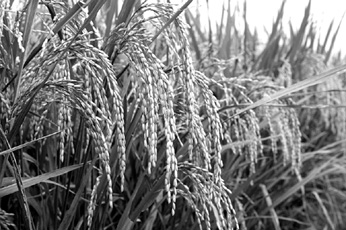 A paddy field at BRAC's Agriculture Research & Development Centre, Gazipur.
A paddy field at BRAC's Agriculture Research & Development Centre, Gazipur. Since the advent of modern varieties (MVs) of rice in Bangladesh, the on-going debate has been that crop diversity has been adversely affected. Before that, farmers used to grow a variety of crops to help maintain ecological balance. In other words, as critics would argue, the increased output from MVs should be weighed against the loss of diversity and the resultant consequences (e.g. reduction in nutritious food and soil fertility). The concern over the loss of diversity is quite understandable as it is required to preserve natural sustenance, soil fertility and nutritional uptake of household members.
It is alleged that widespread cultivation of modern paddy has seriously damaged crop diversity and productivity in rural areas. As critics contend, mono-cropping system has replaced multi-cropping. But over time, ecological balance has been significantly eroding with the advent of modern paddy. Keeping this debate in mind, we can draw upon empirical information to grasp the gravity of the situation.
From the list of varieties of paddy grown in different seasons we observe that ten varieties occupy roughly 60 per cent of the land in Aus season. Of course, more varieties could be there but our survey has failed to capture them. Out of these 10 varieties, BR-2, BR-1, Parijat and IR-50 were grown on more than half of the total cultivated land. These are modern varieties and all others were traditional. Again, out of the 15 varieties used, only four have yield rate exceeding 3 tons/ha, and the yield rate of other varieties was below 2 tons/ha. Again, according to research findings, a total of 15 varieties claim about three-fourths of the land in Aman season. This means, only 15 varieties claim the lion share of the land in Aman season. Amang them, BR-11, Swarna, Pajam and Digha are noteworthy. It may be mentioned here that some of the varieties grown in Aman season, such as Swarna, have originated from India. However, there may be more varieties grown in Aman season, but our survey could not identify them. In this season also, only a few varieties produce more than 3 tons/ha. These are, for example, BR-11, Paijam, BR-32, BR-30 etc. In the Boro season, only 11 varieties dominate the scene capturing about three-fourths of the land under cultivation. We presume that there are more varieties grown by farmers in Boro season that lay outside our survey-lens. However, only six varieties such as BR-28, BR-29, BR-14, BR-8, BR-1 and Ratna are reported to be the most popular in survey areas. In Boro season, the average yield of these varieties exceeds 5.0 tons/ha, and the yield rates of the remaining varieties appear to be higher than the highest for varieties used in other two seasons. This explains the reasons for an increasing switch-over of farmers from traditional varieties to modern ones, particularly in Boro season.
Therefore, our survey data does not seem to accept the allegation that farmers have been growing only one variety since their switch-over to modern paddy. Undoubtedly, we notice a tremendous spree among them to cultivate modern paddy, but it is clear that they are not using the same variety in the same village. In sample villages, we observed farmers tend to grow 10 to 15 varieties of paddy. The rationale behind using different varieties is mostly topographic. Some lands are very high, some very low and some are medium types of land. Even if the farmers do not target the maintenance of crop diversity, they are in fact forced towards that by the very nature of the crops that they cultivate. In the meantime, the economic logic also appears no less important and convincing. What farmers do, in fact, is to spread the risks by growing a number of varieties with different levels of elevation. The loss of crops in one plot is then compensated by gain in other plots. Another factor that provides incentive to the maintenance of crop diversity is taste of consumers. By growing different varieties of paddy, farmers tend to respond to different tastes of paddy demanded by the consumers in the market. Any way, the apprehension that crop diversity in rural Bangladesh was lost due to modern paddy is not possibly true, as specially our collected information does not indicate that.
We now turn to the empirics of the issue under consideration. Loss of crop diversity, if at all, should have adversely impinged on the yield of crops by affecting soil fertility. The level of the yield of crops is an important consideration for farmers as well as for policy-makers. It appears that among all crops, the yield levels of MVs (Aman and Boro) have depicted a sharp upward trend. For example, in the 1980s, the yield of Boro paddy was 4.43 tons per ha which has appreciably reached 6.4 tons per ha in recent years. For Aman, the yield levels stood at 3.3 and 3.6 tons respectively. Thus our observation on increasing yield of paddy apparently stands against the prevailing perception that yield levels have been declining in Bangladesh over time. But at the same time, one also needs to be cautious in interpreting the average yield lest it conceals the regional differences. Interestingly, the yield level of transplanted varieties (TVs) in Aus season has increased while that of MVs has fallen over time. Besides paddy, the increasing trend of yield also applies to all other non-paddy crops - sharply in the case of potato and sugarcane. In a regime of limited and also declining land space, increase in yield levels and hence of land productivity, surely sounds soothing.
The writer is Professor
of Economics at
Jahangirnagar University. abdulbayes@yahoo.com
© 2025 - All Rights with The Financial Express
